The New Jersey drops anchor with Castillo on board at berth 7 in Ulithi lagoon on the morning of 9 November 1944, she has been at sea for 33 days and steamed 14 784 miles. The crew proceeds with fuelling and provisioning the ship as well as conducting minor repairs and upkeep.[1]NEW JERSEY – War Diary, 11/1-30/44 – page 10
Castillo makes an entry into the journal that he goes ashore 12 November to serve at a party held by Admiral Halsey. In attendance was about 25 nurses from a naval hospital ship. All the officers seem to have had a good time drinking and dancing while Castillo serves as a bartender.[2]Conrad F. Castillo journal – page 23
The location of the party could have been on Mog-Mog, an island among the numerous small islands within the Ulithi Atoll. Turned into a recreation site for sailors Mog-Mog each day received as many as 15 000 air and naval crew swarming the sixty-acre island for some well-earned recreation.
Ashore crew engaged in the four B’s; Bathing, Baseball, Boxing and Beer Drinking – but only from 1pm – 6 pm…and only with an allotment of three beers per sailor sold for twenty-five cents apiece.
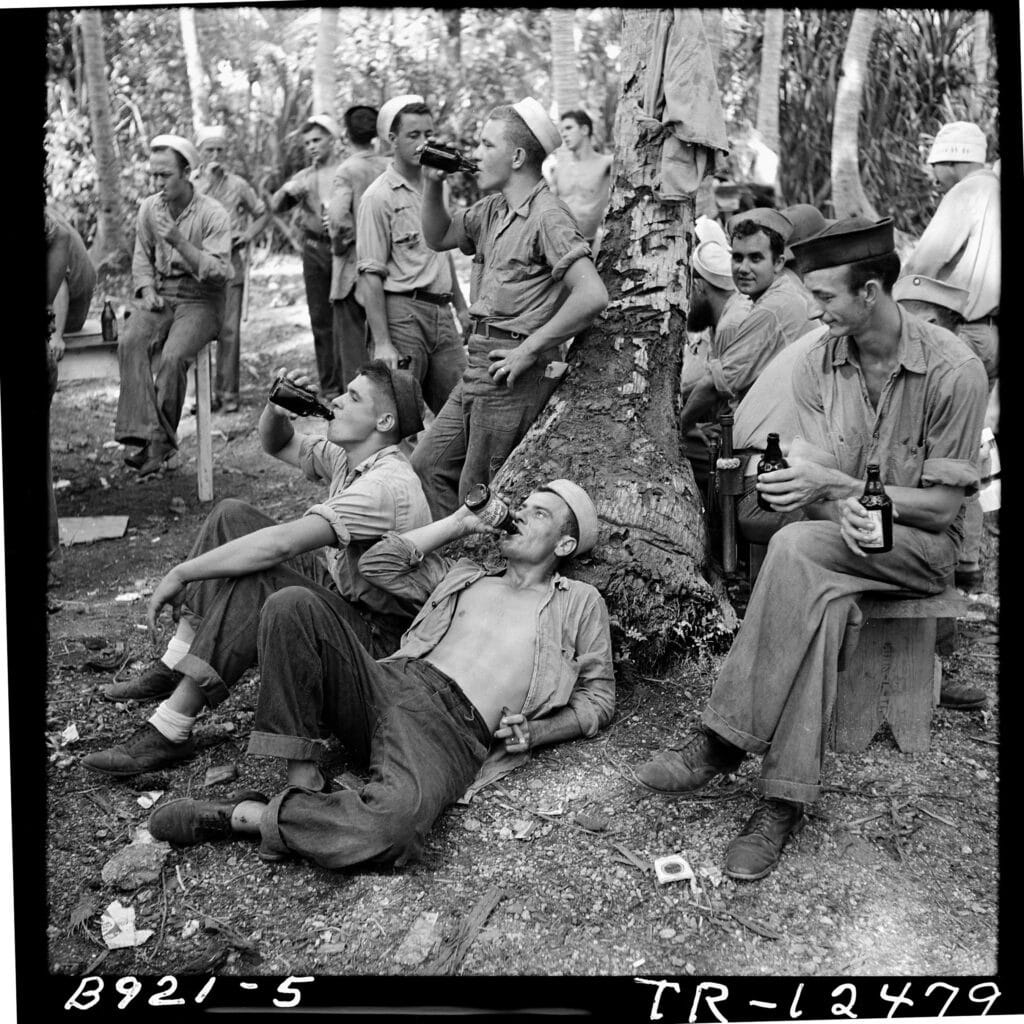
Navy personnel on liberty at Mogmog Island. Enlisted men lounge about a tiny island with plenty of beer.
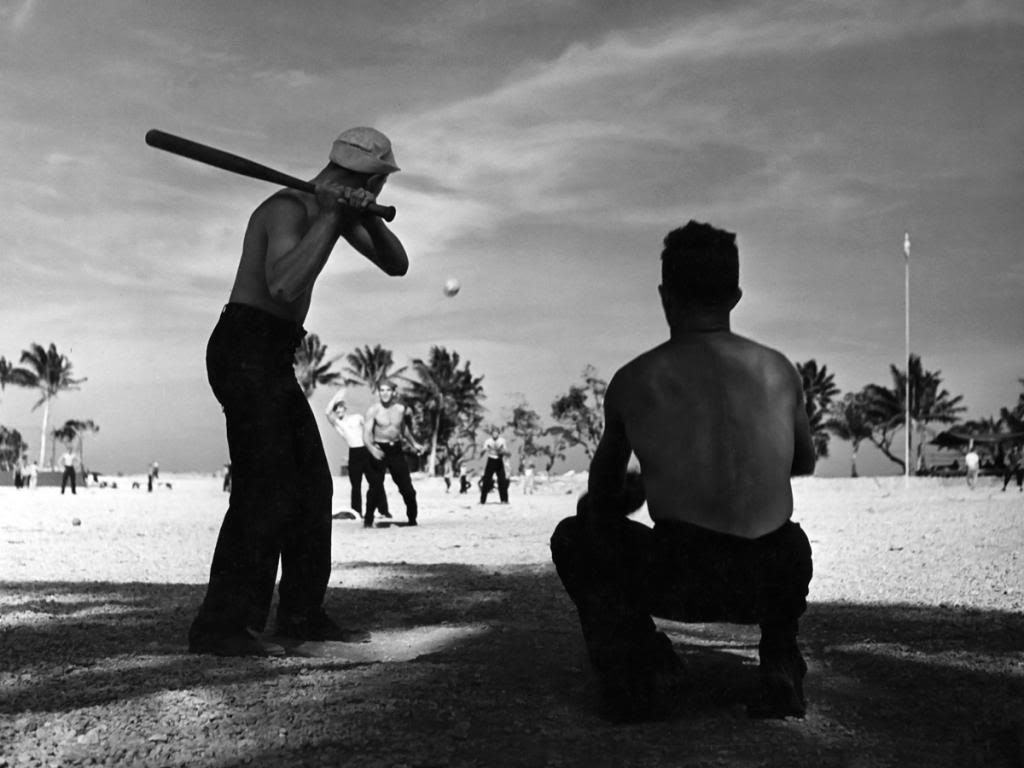

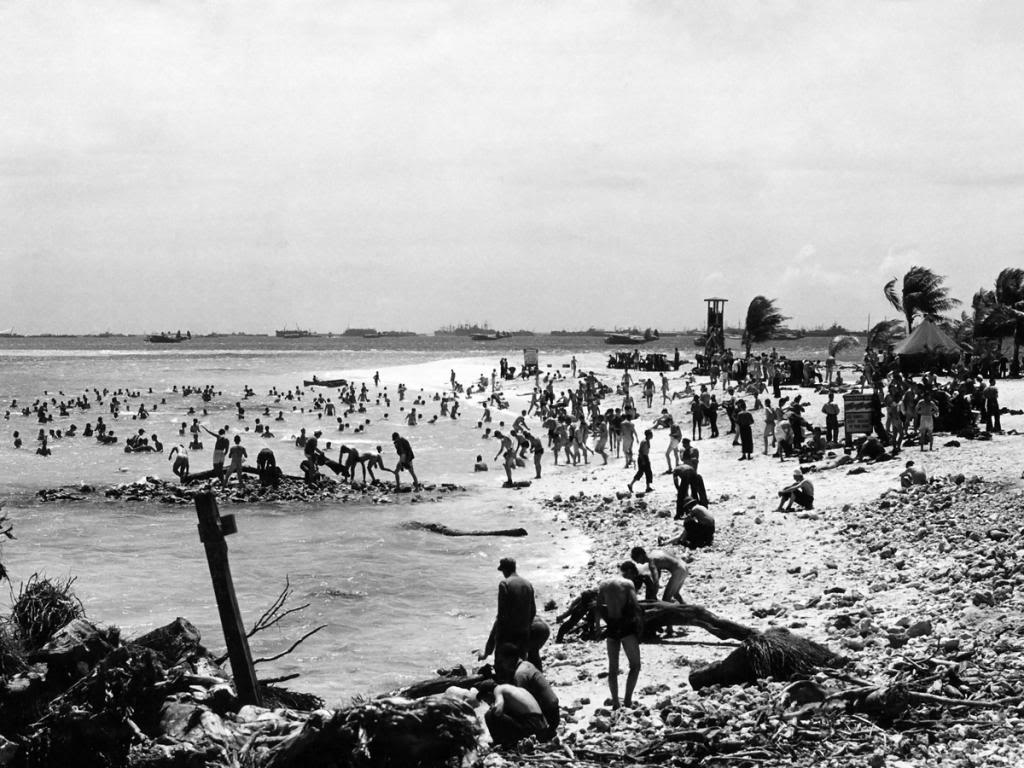
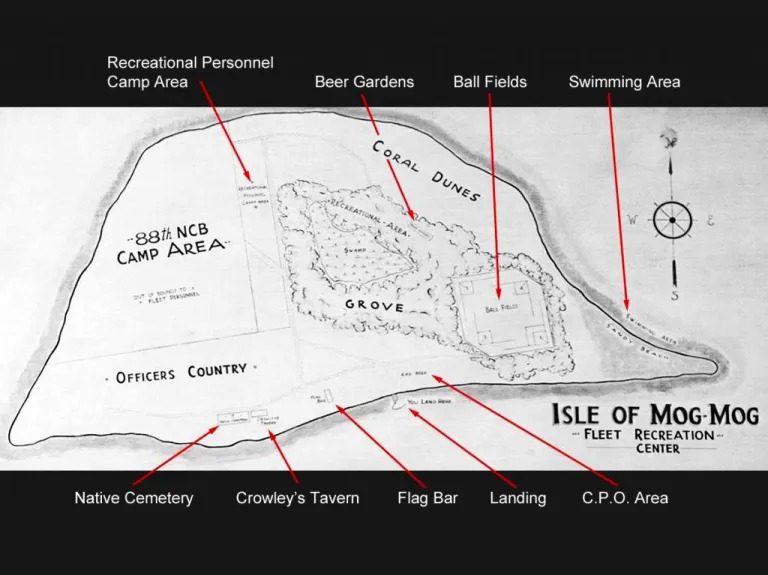
https://mighty90.com/15_Mog_Mog.html
Officers and enlisted men socialised at separate places according to their ranks. On the opposite side of the island was “Officers Country” where Crowley’s Tavern was the most prominent establishment. Housed in a hut previously belonging to former Mog Mog chief, King Ueg, officers could in this palace drink as much beer they wanted.
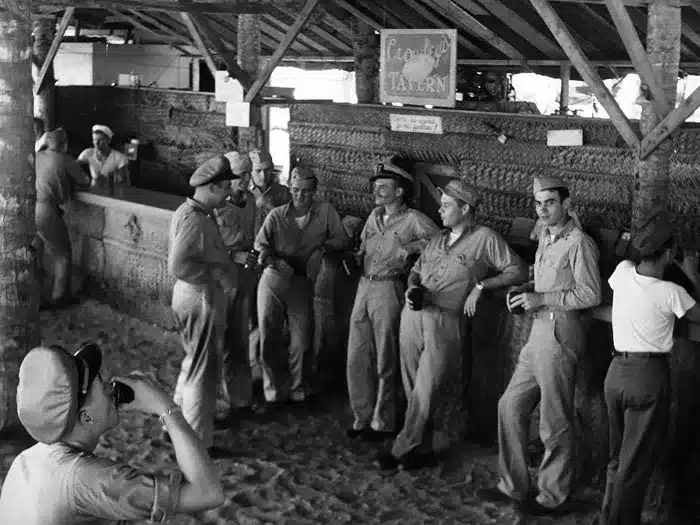
To-date we have been unable to establish if it was here, in Crowley’s Tavern, that Admiral Halsey housed a party for high ranking officers and 25 nurses as the establishment was considered as a junior officers club. The location of the party is still being investigated, it could have been held at what was referred to as the “Flag Bar” or maybe within the quarters of Ulithi’s commanding officer Commodore Worrall R. Carter. Any clarification that can be provided would be highly appreciated.
The nurses in attendance at Admiral Halsey’s party were most likely either from the hospital ships USS Solace (AH-5) or USS Samaritan (AH10) that at the time both were on permanent station in the lagoon. The nurses were the day after treated to dinner on board USS New Jersey.
Kamikaze attacks – 25 November 1944
Castillo and the ships in Task Group 38 again came under attack from Japanese Kamikaze’s on 25 November 1944, this time in greater force. Summarising from the New Jersey action report from this day it paints a harrowing tale.
- 1230 – several enemy planes were sighted high and astern of the task group, shortly after they attacked.
- 1232 – the New Jersey takes a ZEKE under fire as it dives on the USS Hancock missing with its bomb. The plane is disintegrated mid-air by gunfire, a burning section of the fuselage lands on the carrier’s flight deck.
- 1252 – two ZEKEs initiates an attack on the USS Intrepid that is steaming in formation behind the New Jersey. Both planes are taken under fire by the ship with one exploding in the air and crashing into the water. The other plane is hit but succeeds in crashing into the flight deck of the carrier starting large fires.
- 1255 – the New Jersey opens fire on a ZEKE coming down in a spin over USS Iowa. The plane is hit but believed to have been previously shot down by Iowa.
- 1258 – the New Jersey takes a ZEKE under fire as it dives towards the USS Cabot from astern. The plane overshoots its dive but trips a wing on the flight deck of the Cabot before crashing into the water on the port bow of the carrier.
- 1259 – the New Jersey fires on a ZEKE high and overhead, at the same time another plane makes a suicide dive on the USS Intrepid, still on fire from previous hit, and hits the ship a second time.
- 1300 – the New Jersey takes a ZEKE under fire from ahead of the ship diving on the USS Cabot. The plane is shot down in flames well short of its target.
ZEKE = the allied reporting name for the Mitsubishi A6M “Zero”
Firing by the Task Group continues until 1307 and enemy planes remain in the vicinity until 1415 with at least a further three planes were shot down by CAP (Combat Air Patrol) efforts.
Securing from general quarters at 1500 the ship has expended 78 rounds of 5”/38, 702 rounds of 40 mm and 2242 rounds of 20 mm ammunition. The ship has scored two definite destroyed planes and assisted in the destruction of four more.
Incredibly, the first suicide attack on USS Intrepid is captured photographed from the USS New Jersey BB62. Incredibly the last fractions of a second before the Kamikaze impacts the flight deck of the USS Intrepid are captured in below photo.
The gun crews of the New Jersey, having just stopped firing on the plane not risking to hit the Intrepid, can only helplessly watch the plane impact the ship.
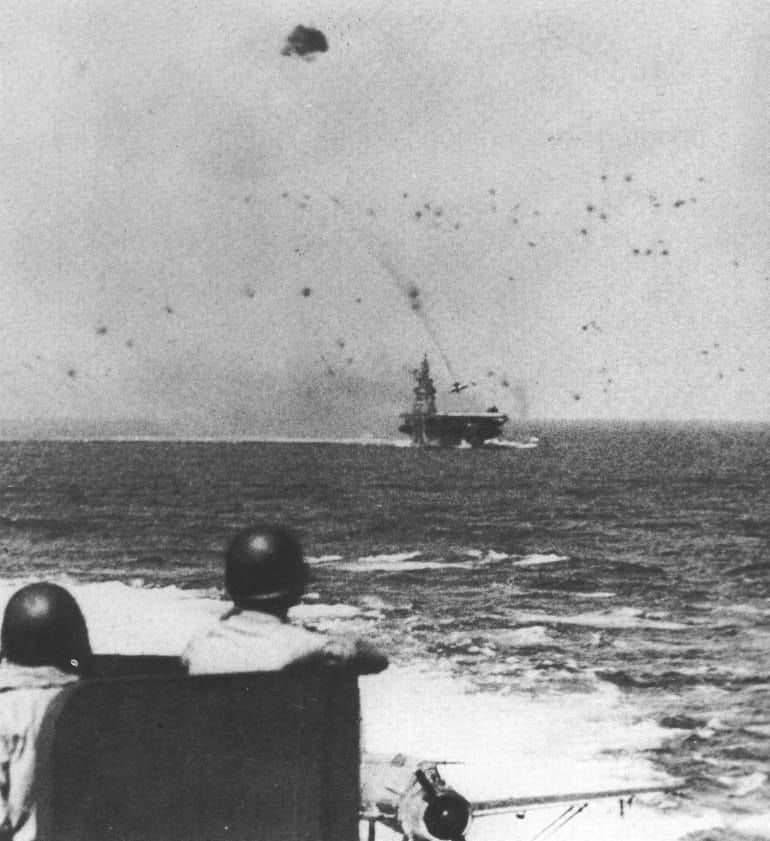
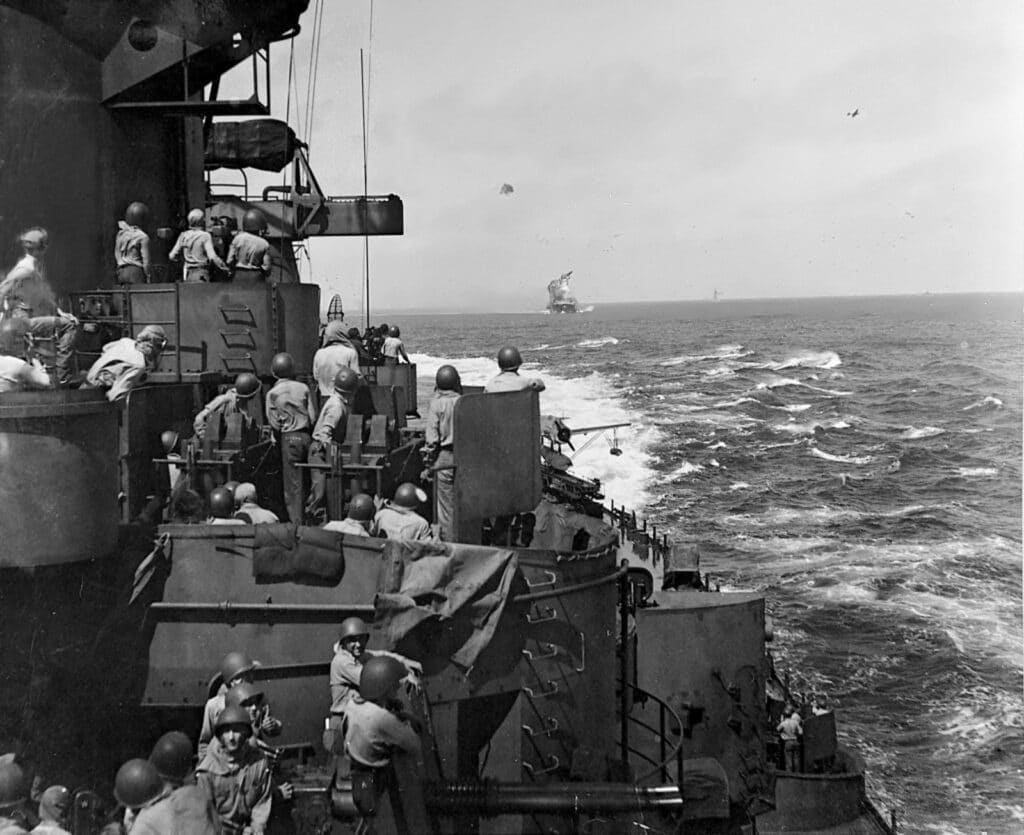
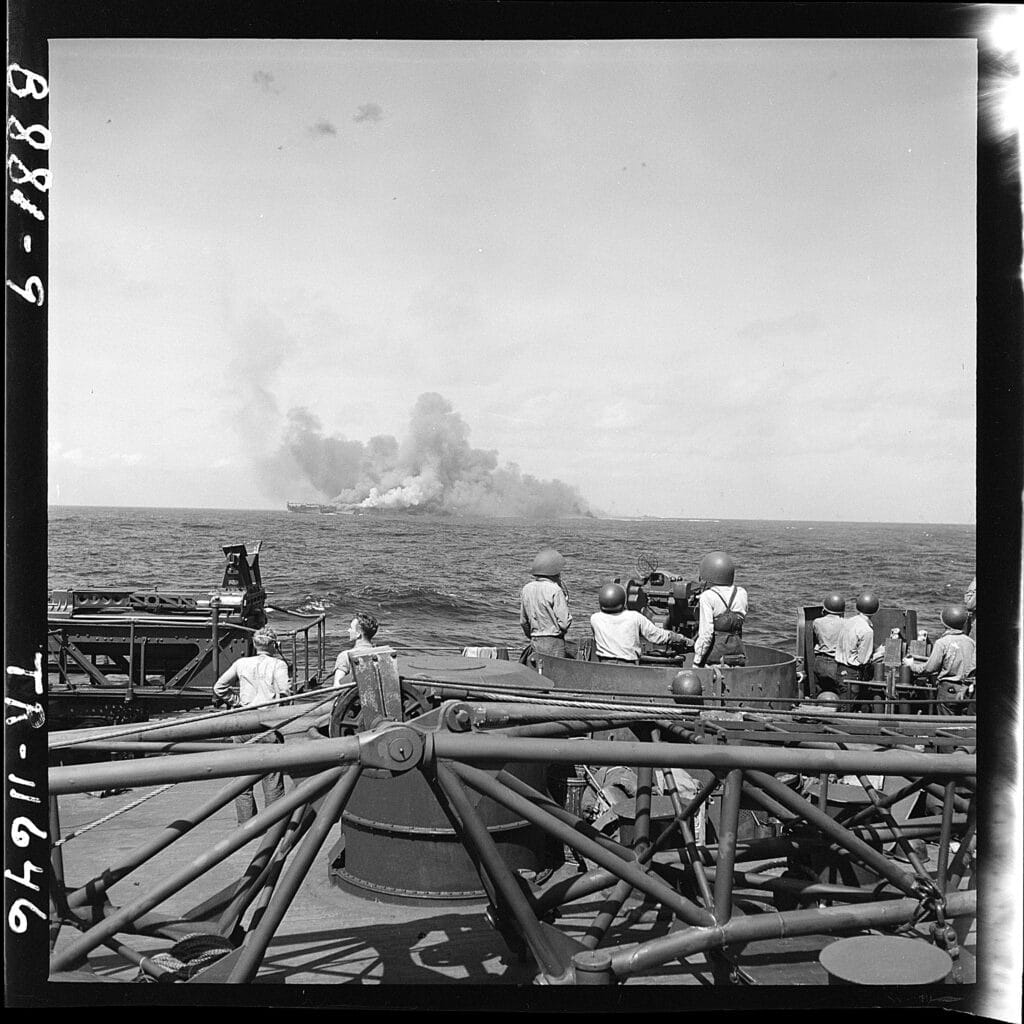
080-G-0470268_04-0426M
The image of USS Intrepid engulfed in smoke above, as seen from USS New Jersey, while frantic efforts are made to save the ship.
Castillo mentions the ship being on fire for two hours thinking it would sink and that all her planes landed on Leyte instead. At 2:30pm he reports in his journal that she is almost out of smoke and floating normally again.
The USS Essex (CV-9), operating in Task Force 38, is also hit by a Kamikaze on this day. Striking the port edge of her flight deck the Kamikaze aircraft crashes among planes made ready for take-off killing 14 sailors and wounding 44. Although the damage is heavy the ship was able to stay at sea once the fires were extinguished. It is unknown whether Castillo at the time was aware that his brother’s ship had been hit. Given his proximity to Admiral Halsey’s Flag staff one must assume he was made aware at some point.

Official U.S. Navy Photograph, now in the collections of the National Archives.
Catalog #: 80-G-273032[3]https://www.history.navy.mil/our-collections/photography/numerical-list-of-images/nara-series/80-g/80-G-270000/80-G-273032.html
A big storm – 17 & 18 December 1944
Castillo’s journal for December 17 simply reads, “a bad day; we are fighting a big storm.” The reality behind the entry is much more profound as the storm he refers to is Typhoon Cobra. This was the US Navy designation for the tropical cyclone that has also has become known as “Halsey’s Typhoon”.
At the time the of the typhoon’s formation the Third Fleet was conduction operations east of Luzon in Philippine Sea. Information provided to Admiral Halsey about the typhoon location and direction was not accurate, as a result the Third Fleet sailed into the centre of the typhoon.
The damage to the fleet was severe as they encountered winds up to 140kn (160mph) and heavy seas, some ships rolling more than 70 degrees. When the storm subdued three ships had capsized and sunk with 790 sailors perishing while several other ships had sustained damage.
The three lost ships were USS Spence (DD-512), USS Hull (DD-350) and USS Monaghan (DD-354). All three ships were destroyers and had nearly empty fuel stores so lacking the stabilizing effect of the extra weight. Rolling so severely that water flooded down their smokestacks disabling engines left them at the mercy of the winds and seas until they sank.
The carrier USS Monterey (CVL-26) was nearly lost due to fires breaking out from its own air planes crashing into bulkheads and exploding during violent rolls. One of those fighting the fires aboard the ship was Lt. Gerald Ford who would later become the 38th President of the United States.
In all 93 men were rescued of the over 800 men presumed missing in the three ships. While desperately fighting the typhoon itself the destroyer escort USS Tabberer (DE-418) encountered and rescued a survivor from the Hull. This was the first from any of the capsized destroyers and shortly thereafter many more were picked up.
USS Tabberer eventually picked up 55 of the 93 survivors over a 51-hour search disobeying repeated orders from Admiral Halsey to return all ships to port in Ulithi. Despite disobeying fleet orders her skipper, Lt Cmdr Henry Lee Plage, was awarded the Legion of Merit by Admiral Halsey. The Tabberer’s crew was awarded Navy Unit Commendation ribbons which were the first ever to be awarded.
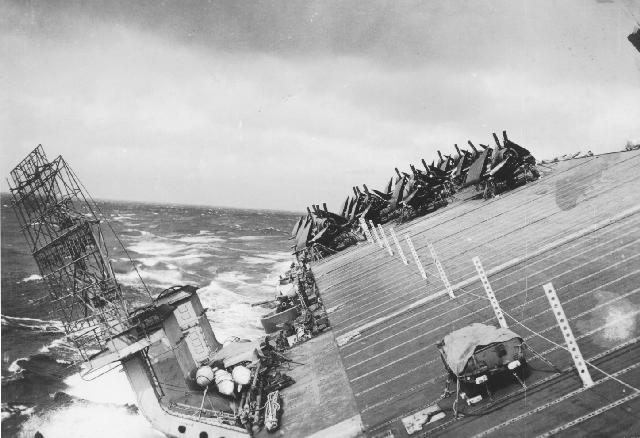

Even a capital ship like the USS New Jersey (BB-62) with her size pitched and rolled, hanging near the point of no return. Admiral Halsey’s own words may best describe the conditions:
“…this typhoon tossed our enormous ship like if it was a canoe. The 70-foot seas smash you from all sides…At broad noon I couldn’t see the bow of my ship, 350 feet from the bridge…What it was on a destroyer one-twentieth the New Jersey’s size, I can only imagine.” [6]https://www.battleshipnewjersey.org/the-ship/full-history/
Shelled at Ulithi – 24 December 1944
On 24 December the typhoon battered Third Fleet returns to Ulithi with the New Jersey passing the entrance buoys at 0556 and anchoring in berth 7 at 0736.
The 1944 Christmas Eve has a rude awakening when at 1032 the ship is straddled by a salvo of 5” shells fired from vessels conducting a target practise from a point approximately 13 000 yards away.
Castillo recounts the event in an entry stating the projectile went through to the third deck and that several boys were hurt and that one lost his leg.
The projectile had struck the main deck, starboard side, at frame 186 and penetrated two decks coming to rest in the crew’s head and wash room. Although it failed to detonate it had injured two men slightly and a third seriously.[7]USS NEW JERSEY – War Diary, 12/1-31/44 – Page 17
In an interview published on “Witness To War Foundation” website with Mr Ed Bean, who also served on USS New Jersey (BB-62), recalls the incident. As the shell passed through the second deck it hit Bean’s friend, Robert Clower, on the foot and part of his leg. Fortunately, Ulithi lagoon had two hospital ships on permanent station and Clower was received and cared for on USS Samaritan AH10[8]USS SAMARITAN (AH-10) Report of Changes – December 1944 . After several surgeries he was given an Honorable Discharge from the US Naval Hospital in Dublin, Georgia on June 4th 1946.
Despite being considered as “friendly fire” Clower through life jokingly always claimed “it wasn’t very friendly”. He never held any animosity about the injury, even refusing to accept a Purple Heart medal as his injury was an accident and not in battle facing the enemy. [9]https://www.rainwaterfuneralhome.com/obituaries/Robert-Bob-Clower/#!/Obituary
It would take some 45 years until friends Clower and Bean, who went through boot-camp together, would reunite.
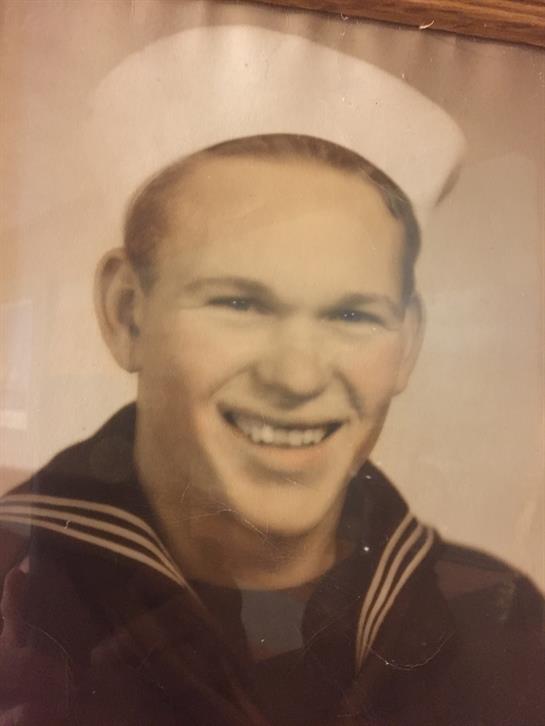
24 July 1925 – 5 June 2020
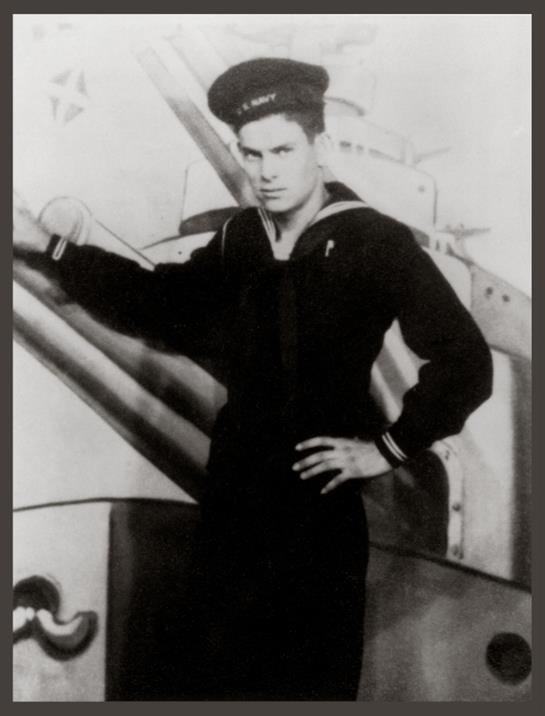
2 August 1925 – 4 February 2022
Christmas at Ulithi – December 1944
At 1350 on December 24th, while anchored in Ulithi, the newly promoted Fleet Admiral Nimitz is piped aboard the ship for a conference with Admiral Halsey. The five-star flag was broken for the first time in history of the United States Pacific Fleet.
In what must also have been a first the Fleet Admiral had, in his flag plane, brought a Christmas Tree complete with trimmings onboard the ship which “contributed to the Christmas spirit on the occasion”.
Castillo notes the occasion in his journal adding that both Halsey and Nimitz made speeches at dinner. In subsequent entries one can sense his mood to be slightly subdued noting that this is his third Christmas Day away from home. At the time of his entry 25 December 1944, he has spent more than 2 years and 7 months away from home.
Christmas is celebrated onboard the ship where a grand Christmas Day meal is served consisting of Roast Tom Turkey, Creamed Peas & Carrots, Virginia Baked Ham, Creamed Whipped Potatoes and more.
Perhaps the out of place Christmas arrangements on a battleship in a combat zone, only hours after being hit by a 5” projectile, ignited a spark of despair and homesickness. Castillo’s entries for 26-27-28 December simply state “is like any other day” while the 29th state “a farewell party” without mentioning for who. Assuming it may have been Nimitz as he departed Ulithi for Saipan that day.
The Third Fleet gets underway from Ulithi in the morning of 30 December to strike Formosa.
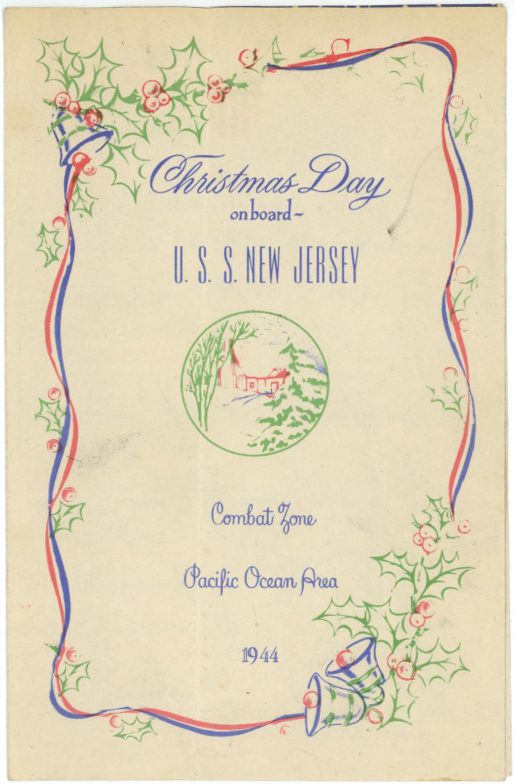
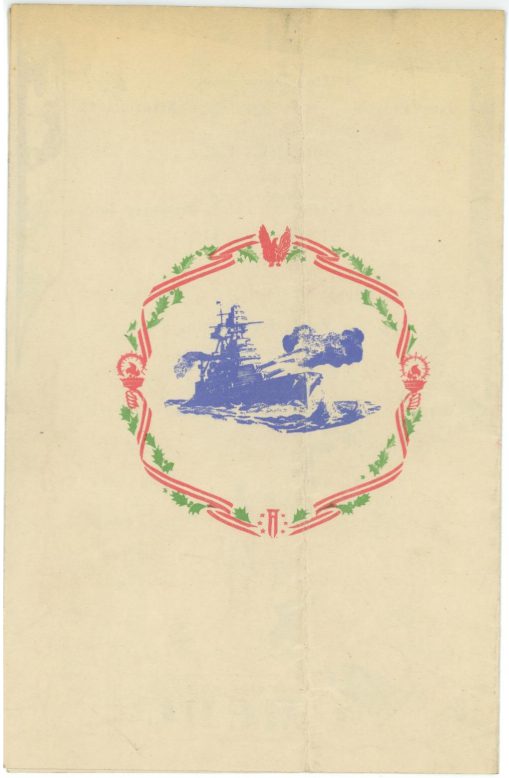
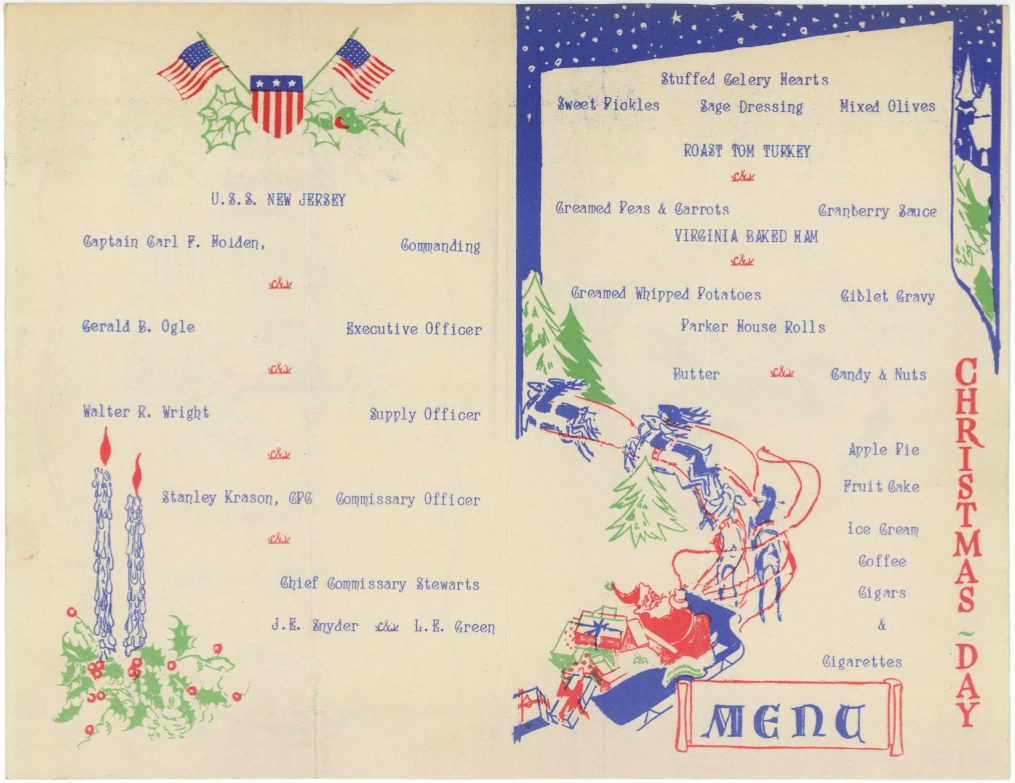
The end of the 1st cruise – January 1945
Returning to Ulithi Atoll on 26 January 1945 Admial Halsey, as previously directed by CINCPAC, passes command of the Third Fleet to Admiral Spruance whereupon its designation changed to Fifth Fleet.
Operational control is formally transferred at 0000 on 27 January 1945 ending a five-month long period where of unprecedented and historic operations with many firsts. Admiral Halsey leaves New Jersey at 0600 and departs for Pearl Harbor in his Flag Coronado with other officers of his Staff.
Before leaving the ship, Admiral Halsey is photographed with his Staff and Flag Allowance. The below undated photograph, from Castillo’s personal image collection, appear to be taken while at anchor in Ulitihi.
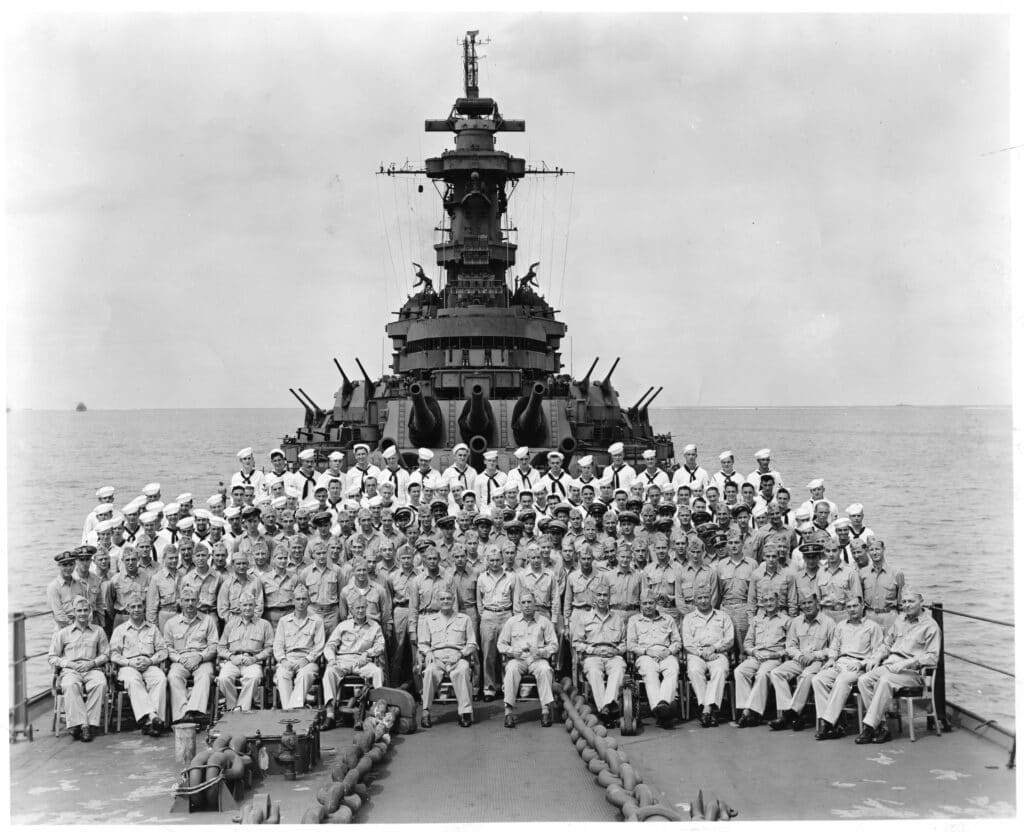
Steward 1st Class Conrad F. Castillo seen circled in middle.
Date and location unknown – but most likely in Ulithi lagoon January 1945
Castillo’s journal does not carry a great amount of detail of these events in general or relating to himself. He simply confirms arrival to Ulithi on 25 January and arriving to Pearl Harbor on 6 February.
From archives one learns that at 0909 on the 27th USS General Sturgis (AP-137) comes alongside the starboard side of New Jersey.[10]USS GENERAL S D STURGIS – War Diary, 1/1-31/45 – Page 2 Confirmed by the USS New Jersey Report of Changes for 26 January 1944 St1c Castillo is among the Staff and Flag Allowance of COMTHIRDFLEET that successfully transfers to the ship.
Casting off from the New Jersey at 1642 and gets underway enroute Pearl Harbor via Eniwetok Atoll with Steward 1st Class Castillo onboard. The General Sturgis, as the only one of her kind, will later be present in Tokyo Bay when the Japanese Instrument of Surrender is signed.
After a brief stop, anchored in Berth L-6, Eniwetok Atoll on 31 January they proceed to Pearl Harbor. Arriving at 1112 on 6 February, they get moored at starboard side to Berth A14 and commence disembarking passengers shortly thereafter.[11]USS GENERAL S D STURGIS – War Diary, 2/1/45 – Page 2
This is where St1c Castillos journal ends with words hinting what will be the next phase of Castillo’s incredible journey. Unfortunately this part of his story will have to be told without his direct assistance taking guidance from his personal collection of documents and memorabilia.
We are leaving 30 days leave to the mainland – second operation – aboard USS Missouri
St1c Conrad F. Castillo
For all parts in the series see below:
- Conrad F Castillo – Part 1 – Beginnings
- Conrad F Castillo – Part 2 – New Zeeland
- Conrad F Castillo – Part 3 – Noumea
- Conrad F Castillo – Part 4 – USS New Jersey BB62
- Conrad F Castillo – Part 5 – Mog Mog, Kamikazes and Typhoons
References


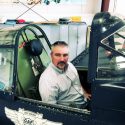
Be the first to comment